
Benjamin Church House is a Colonial Revival house at 1014 Hope Street in Bristol, Rhode Island, U.S.A. It opened in 1909 as the "Benjamin Church Home for Aged Men" as stipulated by Benjamin Church's will. Beginning in 1934, during the Great Depression, it admitted women. The house was closed in 1968 and became a National Register of Historic Places listing in 1971. The non-profit Benjamin Church Senior Center was incorporated in June 1972 and opened on September 1, 1972. It continues to operate as a senior center.

The David Rinehart Anthony House, also known as the Wynne House, was a historic vernacular Greek Revival style house in Eutaw, Alabama. The house was a two-story wood-framed building on a brick foundation. Four octagonal columns spanned the front portico. It was built in 1860 by David Rinehart Anthony. It was added to the National Register of Historic Places as a part of the Antebellum Homes in Eutaw Thematic Resource on April 2, 1982, due to its architectural significance. It has since been destroyed.

The Dahm House is a historic townhouse in Mobile, Alabama. The two-story brick structure was built in 1873 for John Dahm. It was designed by Bassett Capps. A two-story frame addition was added in 1929. The house was added to the National Register of Historic Places on January 5, 1984. In addition to being listed individually on the National Register of Historic Places, it is also a contributing building to the Lower Dauphin Street Historic District.

The Willa Cather Birthplace, also known as the Rachel E. Boak House, is the site near Gore, Frederick County, Virginia, where the Pulitzer Prize-winning author Willa Cather was born in 1873. The log home was built in the early 19th century by her great-grandfather and has been enlarged twice. The building was previously the home of Rachel E. Boak, Cather's grandmother. Cather and her parents lived in the house only about a year before they moved to another home in Frederick County. The farmhouse was listed on the Virginia Landmarks Register (VLR) in 1976 and the National Register of Historic Places (NRHP) in 1978.

The Metzger House is a historic residence in Mobile, Alabama, United States. The one-story Italianate-influenced brick structure was built by the Metzger family in 1875. It was added to the National Register of Historic Places on January 5, 1984, due to its architectural significance.
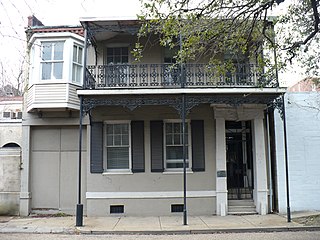
The Phillipi House, also known as the Mastin House, is a historic residence in Mobile, Alabama, United States. The two-story brick masonry structure was completed in 1850. It is built in a traditional Mobile townhouse style with a Greek Revival door surround and a second floor cast iron balcony across the front elevation. It was added to the National Register of Historic Places on January 5, 1984, based on its architectural significance.
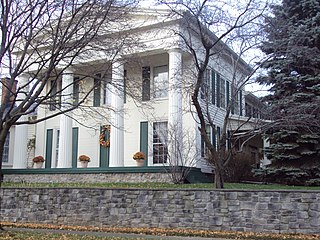
The Rudolph Nims House is a private residence located at 206 West Noble Street in the city of Monroe in Monroe County, Michigan. It was listed as a Michigan Historic Site on October 29, 1971 and added to the National Register of Historic Places on October 18, 1972.

Edgewood, also known as the Thomas House, is a historic Federal-style house in Montgomery, Alabama. The two-story frame building was built in 1821 by Zachariah T. Watkins. It is the oldest surviving residence in Montgomery. It was added to the National Register of Historic Places on April 24, 1973.

The Cassimus House is a historic Queen Anne style house at 110 North Jackson Street in Montgomery, Alabama. The two-story frame house was completed in 1893. It is the last residential structure remaining in its city block. It was added to the National Register of Historic Places on August 13, 1976.

The Gay House was a historic Queen Anne style house in Montgomery, Alabama. The two-story frame building was built by the Hugger Brothers Construction Company in 1900 for Charles Linn Gay. Gay, born on November 8, 1862, was a Montgomery businessman. He died on July 4, 1928. The house was added to the National Register of Historic Places on March 15, 1975. It was mostly destroyed by fire in October 2007 and the remnants were sold for architectural salvage in July 2011.

The Governor Thomas G. Jones House is a historic Victorian-style house in Montgomery, Alabama. The two-story frame building was built in 1855. It is best known as the residence of Thomas G. Jones, Alabama's 28th Governor. It was added to the National Register of Historic Places on December 8, 1978.

The McBryde–Screws–Tyson House, also known as the Tyson House, is a historic Greek Revival style house in Montgomery, Alabama. The two-story frame building was completed in 1832 and the Greek Revival facade added in 1855. It was added to the National Register of Historic Places on November 28, 1980.
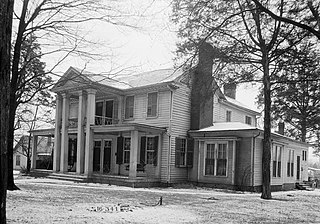
The Houston Memorial Library, previously the Governor George Smith Houston House, is a historic residence in Athens, Alabama. It was built in Federal style in 1835. The house was listed on the National Register of Historic Places in 1986.
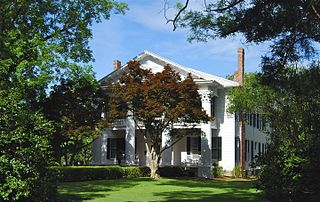
The Hain-Harrelson House is a historic house in Sardis, Alabama. The Classical Revival style structure was completed in 1913 for J. Bruce Hain on his working plantation. The house contains roughly 8,000 square feet (740 m2) spread over two floors. The interior is divided on a central hall plan. The front exterior is adorned with a monumental two-story Corinthian portico with a full-width second floor balcony. The house sat vacant for more than two decades until it was purchased by Cecil Gayle and Kenneth Parker of Atlanta in 1998. They stabilized and restored the home to its original condition. It was added to the National Register of Historic Places on November 30, 2001. The home was purchased in December 2015 by Ray and Angie Harrelson of Selma, AL.
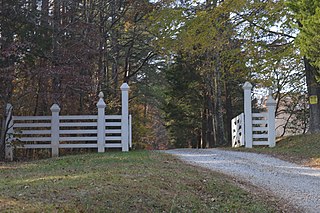
Westview, also known as the Elam Homestead and Terrell Place, is a historic plantation house and farm located in Charlotte County, Virginia; the nearest community is Brookneal, which is in Campbell County. It was built in 1832, and is a two-story, three bay, single pile, brick dwelling in the Federal style. It has two later frame additions. Also on the property are three contributing log slave cabins, a frame milk house, log smokehouse, log schoolhouse, log shed, two barns, a stable / hay barn, ice pit, a family cemetery, and a slave cemetery.

The White–Turner–Sanford House is a historic residence in Huntsville, Alabama. It was built in 1827 by James White, a merchant from Virginia, on land purchased from LeRoy Pope. The home has had numerous owners through the years including John H. Lewis, mayor from 1826 to 1828, and state representative George W. Lane. Originally a one-story Federal-style house, a two-story Greek Revival addition was built in 1858. The original part of the house consists of a center-hall main block with an ell. It is built of brick laid in common bond, with a gable roof. A portico supported by four thin columns covers the main entrance, which sports a four-panel transom. Windows on the main block are the original rectangular sashes, except the windows on the façade which were modified with segmental arched tops to match the addition. The original portion contains a hall flanked by a parlor and reception room, with two bedrooms behind the parlor. A porch, kitchen, and bath filling in the ell were added after the Civil War. The addition has a study and dining room on the ground floor and two bedrooms above. The house was listed on the National Register of Historic Places in 1984. It has been converted into a financial planning office.

The Jude–Crutcher House is a historic plantation house in Huntsville, Alabama. The house was built circa 1812 on land deeded that year to Samuel Echols. Echols sold 54 acres and the house to George Jude, Sr., in 1817. Jude died two years later, leaving the land to his son, George Jr. The younger Jude eventually acquired 800 acres and owned 31 slaves. Upon his death in 1873, the land stayed in the family until 1883. In 1906 David Crutcher, who had been born a slave on an adjacent plantation in 1851, purchased the house and 154 acres along with two other African-American men. The Crutchers operated a successful farm on their portion of the land, which was an extension farm for Alabama A&M University until the 1940s. Only 7% of African-American farmers in Madison County in 1910 owned their own farms. David died in 1924, and his wife, Lucy, died in 1943, although the house and land is still in the family.

The Forest Home is a historic residence near Trinity, Alabama. The house was built in 1856 on land given to him upon his father-in-law's death. Davis was a farmer, a teacher at LaGrange College, and a leader of the Grange movement of farmer advocacy. The house remained in the Davis family as a working cotton farm until 1973. The house is a two-story I-house with a single-story rear ell. A two-story porch adorns the front façade. The house was listed on the Alabama Register of Landmarks and Heritage in 1979 and the National Register of Historic Places in 1980.

Woodside is a historic residence in Belle Mina, Alabama. The land on which the house was built was originally part of Alabama Governor Thomas Bibb's estate, Belle Mina. Thomas' son, Porter Bibb, built Woodside in 1861 for his daughter, Mary Chambers Bibb. The two houses stand one-half mile (1 km) apart. Woodside is a two-story Greek Revival house, originally with a central, double-height portico that was extended to the full width of the façade in the early 1900s. The house has a center-hall plan, with two rooms on either side of a hallway on both floors. The rear of the house was originally a pair of one-story wings, but a second story was added in an early 20th-century renovation. Greek Revival details continue inside the house, such as mantels and architrave-framed panels in the stairwell. The house was listed on the National Register of Historic Places in 1982.

Preuit Oaks is a historic plantation house near Leighton in Colbert County, Alabama. The house was built in 1847 by Dr. John S. Napier, on land originally owned by his father-in-law. The house and land were sold in 1851 to W. Richard Preuit, who developed the property into a large cotton plantation. At its peak in 1860, the plantation covered 1,500 acres ; following the Civil War, its productivity declined, and Preuit's holdings had depleted to only 400 acres upon his death in 1882. The house has remained in the family since.























